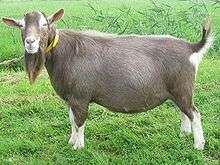Toggenburg goat
 | |
| Conservation status | no concern |
|---|---|
| Other names |
|
| Country of origin | Switzerland |
| Distribution | worldwide |
| Standard | Schweizerischer Ziegenzuchtverband |
| Use | milk |
| Traits | |
| Weight | Male: 75 kg[1] |
| Female: 55 kg[1] | |
| Height | Male: 85 cm[1] |
| Female: 75 cm[1] | |
| Horn status | horned or hornless |
| Tassels | with or without tassels |
|
Goat Capra aegagrus hircus | |

The Toggenburg or Toggenburger is a Swiss breed of dairy goat. Its name derives from that of the Toggenburg region of the Canton of St. Gallen, where it is thought to have originated. It is among the most productive breeds of dairy goat.
History
In 2006, in Switzerland where the breed was officially recognized in 1892, there were 850 goats in the Toggenburg and the Werdenberg region of 3000 in Switzerland, which is down from 20,000 in the 1950s. The club St. Gallen Goat Breeders Association, that was founded in 1901, registers the breed. The Verein Ziegenfreunde was formed to protect the breed and unite breed owners.[2]
The Toggenburg breed underwent a development program when introduced to Britain; the resulting British Toggenburgs are heavier and have improved milk quality. By the middle of 2002, 4146 Toggenburgs had been registered with the New Zealand Dairy Goat Breeders Association,[3]
Characteristics
The Toggenburg is of medium size. Coat colour ranges from light brown to mouse grey, with white Swiss markings to the face, lower legs and tail area.[1] Tassels may be present; billies and nannies may be horned or hornless.[1] The facial profile may be concave or straight, but not convex.[4]
Use
The Toggenburg is a highly productive dairy breed. The breed standard calls for minimum milk yield of 740 kg per lactation, with a minimum fat content of 3.56% and minimum protein content of 2.90%.[1]
References
- 1 2 3 4 5 6 7 Toggenburger Ziege (in German). Schweizerischer Ziegenzuchtverband. Archived 2 October 2016.
- ↑ "Slow Food Presidia". Retrieved December 14, 2014.
- ↑ "New Zealand Dairy Goat Breeders Association". Retrieved December 14, 2014.
- ↑ "American Dairy Goat Association". ADA. Retrieved December 14, 2014.